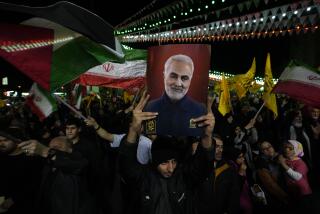Syria’s Assad was in a strong position a week ago. A suspected chemical attack changed everything
Just a few days ago, Syria’s long-embattled President Bashar Assad appeared to be in his strongest position in years.
Members of President Trump’s foreign policy circle had signaled a definitive break from the Obama administration’s “Assad must go” refrain — the insistence that the departure of Syria’s autocratic leader was a precondition to any long-term solution in the violent crisis that has roiled the Middle East for more than six years.
“Our priority is no longer to sit and focus on getting Assad out,” Nikki Haley, U.S. ambassador to the United Nations, said last week, while Secretary of State Rex Tillerson said it was up to the “Syrian people” to decide Assad’s ultimate fate.
The comments seemed finally to signal a convergence of Syria strategy between Washington and Moscow, longtime antagonists on the question of Syria. Assad, it seemed, could be part of the solution after all.
How things have changed.
This week’s suspected chemical attack in a rebel-held stretch of northwest Syria has put Assad’s government squarely back in the U.S. cross-hairs.
Washington appears to have concluded that the strike was the work of Assad’s war planes — even before there has been an on-the-ground inquiry into the reported deaths of more than 70 people Tuesday in rebel-held Idlib province.
There have been adamant disavowals from Syria and its ally Russia. Syrian Foreign Minister Walid Moallem said Thursday it was “not reasonable” to assume Syria would resort to chemical weapons when government forces have been making substantial gains on the battlefield. “We condemn such a criminal act,” he said.
But U.S. officials have said radar detected Syrian aircraft in the vicinity of Khan Sheikhoun on the morning of the attack there, and by midday Thursday, Trump was already considering military retaliation.
Critics of the Assad government said the attack, which left victims gasping for breath and foaming at the mouth, is a continuation of years of scorched-earth tactics meant to eradicate the opposition and ensure total victory.
But even if the incident was, as Syrian and Russian officials suggest, instigated by the Syrian opposition to draw international wrath onto Assad’s head, the effect is undeniable: Assad’s position is suddenly more precarious than ever.
“Cooperation with the Assad regime is over,” Paul Salem, vice president for policy and research at the Middle East Institute, a Washington think tank, said in a video statement.
On Thursday, Moscow reiterated its longtime position that its support for Assad is not “unconditional,” President Vladimir Putin’s spokesman, Dmitry Peskov, told the Associated Press. Russia demanded a full investigation before any military action is taken.
Assad has weathered many storms in six years of conflict. There are few alternatives to his government, which still presides over the vast majority of Syrians, and is a sworn enemy of Islamic extremists.
“I think you’ll see some kind of demonstrative strike by the Trump administration and that will be that,” said Joshua Landis, who heads the Center for Middle Eastern Studies at the University of Oklahoma. “American generals are not going to be drawn into the Syrian quagmire. They’ve lived through that for years in Iraq and Afghanistan and are sick and tired of it.”
On the other hand, the chemical incident not only has put the Assad government on the defensive. It may breathe new life into a divided, demoralized rebel force that has been losing territory and has looked to be on the verge of defeat.
Many Syrians have become disillusioned with the armed opposition since it became dominated by hard-line Sunni Islamists, some linked to Al Qaeda.
Yet all diplomatic efforts to stop the fighting have failed, as outside governments continue to pour arms and money to their favored militias.
Now, for the first time since 2013, there is the prospect of U.S. military involvement. A conflict that has already seemed unfathomably complex to many may be headed for a new and potentially more calamitous phase.
It would signal a major departure from a U.S. policy that for years saw billions of dollars of covert aid sent mainly to Islamist rebels fighting to oust Syria’s secular but authoritarian government.
It could also raise the chilling possibility of a direct confrontation between two nuclear powers, the United States and Russia.
For years, the Obama administration resisted such an action, in large part because of a fear that Syria could become a reprise of Iraq in 2003, when U.S. forces toppled Saddam Hussein and the country descended into a chaos from which it has yet to recover. The disastrous consequences of that U.S. intervention have always hovered over the escalating tragedy in Syria.
The Obama team opted for a middle-ground strategy that kept military pressure on Assad with the hope that a negotiated solution for his departure could be brokered. It never happened.
Russia’s decisive intervention in support of Assad, along with considerable aid from Iran and the Iranian-linked Hezbollah movement in Lebanon, threw a lifeline to Assad’s once-reeling government.
With the recapture earlier this year of the city of Aleppo and the eviction of rebel forces from Homs, Assad’s forces now control all major cities. Life in the capital of Damascus has returned to something close to normal.
But the contorted history of the Syrian conflict demonstrates that no one can predict the consequences of any new escalation.
Few who cheered the “Arab Spring”-style protests that broke out against Assad’s rule in 2011 expected that it would become a sanguinary struggle that would revitalize Al Qaeda and give birth to the even more violent militants of Islamic State, which soon swept from Syria through much of northern and western Iraq and dispatched radicalized cadres to Europe to spread terror.
Critics blame what they call Assad’s brutal crackdown and refusal to step down for the catastrophic sequence of events. Assad’s supporters blame a “regime change” operation backed by Washington and its chief allies, including Saudi Arabia, Turkey and Israel. They call it a repeat of the 1980s war in Afghanistan — pitting U.S.-and Saudi-backed rebels against a Soviet-backed government in Kabul — that first gave birth to Al Qaeda.
NEWSLETTER: Get the day’s top headlines from Times Editor Davan Maharaj »
Trump, during his election campaign, had suggested that Assad — and his Russian and Iranian allies — could be partners in the U.S.-backed campaign to defeat Islamic State.
But in the wake of the chemical incident, the U.S. president on Wednesday had a much different message: “My attitude toward Syria and Assad has changed very much,” he told reporters.
“When you kill innocent children, innocent babies, little babies with a chemical gas … that crosses many lines beyond the red line,” Trump said. “Many, many lines.”
McDonnell, the Times’ Mexico City bureau chief, covered the Syrian conflict from 2011-2016.
twitter: @mcdneville
ALSO
Here’s some of what we know about the apparent chemical weapons attack in Syria
Syria and Russia issue rebuke after U.S. airstrike
More to Read
Sign up for Essential California
The most important California stories and recommendations in your inbox every morning.
You may occasionally receive promotional content from the Los Angeles Times.










